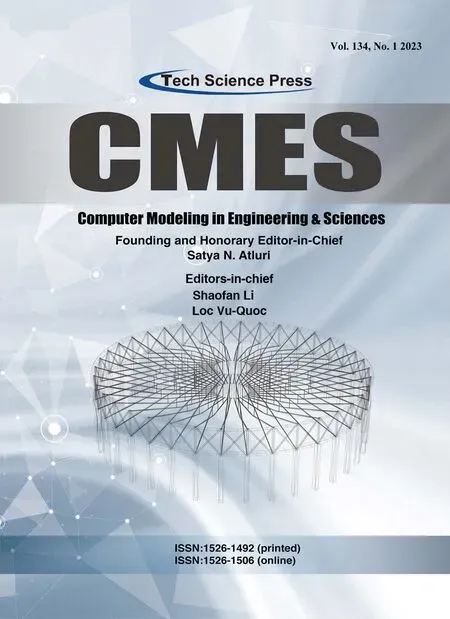Introduction to the Special Issue on Modeling of Heterogeneous Materials
Lisheng Liu,Xihua Chu,Xinhua Yang,Jianzhong Chen and Qun Huang
1Hubei Key Laboratory of Theory and Application of Advanced Materials Mechanics,Wuhan University of Technology,Wuhan,430070,China
2School of Civil Engineering,Wuhan University,Wuhan,430070,China
3School of Civil Engineering and Mechanics,Huazhong University of Science and Technology,Wuhan,430070,China
In order to make up for the shortcomings of homogeneous materials and meet the needs of industry development,heterogeneous materials have been increasingly applied in aviation,automobile,bridge and other fields.Heterogeneous materials refer to advanced materials with non-uniform components.By adjusting the structure or composition of heterogeneous materials,their performance may change in a specific direction to adapt to different environments and achieve special functions.To achieve wide applications of homogeneous materials, it is very important to be able to predict the performance and material response of heterogeneous materials.Modeling method is a basic and important method to accomplish this task.Modeling methods for studying heterogeneous materials include finite element method(FEM),molecular dynamics(MD),peridynamics(PD)and so on.
After peer-reviewed process,ten manuscripts written by researchers from worldwide universities were selected to be published in this special issue,showing the current research status of modeling of heterogeneous materials.
The first paper, “Adaptive Extended Isogeometric Analysis for Steady-State Heat Transfer in Heterogeneous Media”by Fang et al.[1],proposed an adaptive extended isogeometric analysis(XIGA)method based on locally refined non-uniforms rational B-splines (LR NURBS) and simulated the steady-state heat transfer problems in heterogeneous solid.
The second paper,“Behavior of High Strength Concrete Filled Square Steel Tube Stub Columns with Inner CFRP Tube under Biaxial Eccentric Compression” by Yang et al.[2], studied the contribution of carbon fiber-reinforced polymer to the mechanical behavior of high strength concretefilled square steel tube under bi-axial eccentric compression.
The third paper entitled “Peridynamic Modeling and Simulation of Fracture Process in Fiber-Reinforced Concrete”by Chen et al.[3]simulated the fracture behavior of the fiber-reinforced concrete using the bond-based peridynamic model developed by themselves.
Sun et al.[4],in their paper,“Numerical Analysis of Three-Layer Deep Tunnel Composite Structure”,provided a new composite structure of deep tunnel lined with Glass Fiber Reinforced Plastics(GFRP)pipe,which consisted of three layers of concrete segment,cement paste and GFRP pipe.
In the fifth paper,“In-Plane Impact Dynamics Analysis of Re-Entrant Honeycomb with Variable Cross-Section”by Ou et al.[5],the authors designed a new auxetic re-entrant honeycomb structure.They provided a detailed design method of re-entrant honeycomb with variable cross-section(VCRH)and proposed five VCRH structures with the same relative density and different cross-section change rates.
The sixth paper,“Uncertainty Analysis of Seepage-Induced Consolidation in a Fractured Porous Medium”by Guo et al.[6],performed the uncertainty and sensitivity analyses on a seepage consolidation model in a fractured porous medium using the Bayesian sparse polynomial chaos expansion(SPCE)method.
In the seventh paper,“A Simple Cement Hydration Model Considering the Influences of Waterto-Cement Ratio and Mineral Composition”written by Ma et al.[7],they proposed a simple hydration kinetics model which is easy to use and capable of predicting hydration stage of Portland cement.
Zhao et al.[8],in their paper,“Simulation of Elastic and Fatigue Properties of Epoxy/SiO2Particle Composites through Molecular Dynamics,” adopted molecular dynamics simulation to investigate the influence of different nanoparticle sizes on the elastic modulus and the fatigue properties of Epoxy/SiO2nanocomposite.
In the ninth paper,“Optimization of the Drag Forces of Shell Janus Micromotor:A Study Based on Hydrodynamical Analysis and Numerical Simulation”by Wang et al.[9],analyzed the drag forces of shell Janus micromotors by theoretical analysis and numerical simulation.The results provided guidance for the design of Shell Janus Micromotor.
Finally, Basson et al.[10] proposed a novel implementation of the coupled Material Point Method(MPM)which can accurately capture the correct behavior of fluid phase under heterogeneous permeability of the material, in their paper, “A Flux Based Approximation to Simulate Coupled Hydromechanical Problems for Mines with Heterogeneous Rock Types Using the Material Point Method.”
As a final remark,we wish this special issue can contribute to the development of“Modeling of Heterogeneous Materials”and it may benefit broader readers.
Acknowledgement:We would like to thank the authors for their contributions to this Special Issue.We also thank the journal,CMES,for their support for the publication of this Special Issue.
Funding Statement:The authors received no specific funding for this study.
Conflicts of Interest:The authors declare that they have no conflicts of interest to report regarding the present study.
 Computer Modeling In Engineering&Sciences2023年1期
Computer Modeling In Engineering&Sciences2023年1期
- Computer Modeling In Engineering&Sciences的其它文章
- Introduction to the Special Issue on Blockchain Security
